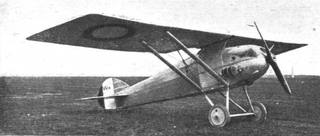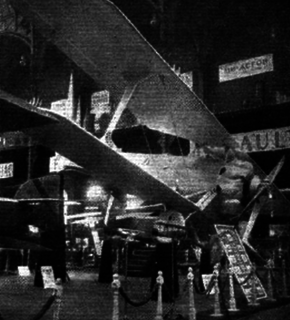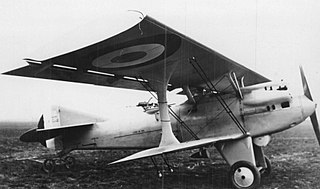
The Kondor D 6 was a prototype German biplane fighter aircraft flown in 1918. In the interests of better upward vision for the pilot, its upper wing was in two halves, separated over the central fuselage. Its development was soon abandoned.

The Pfalz D.XV was a German single seat fighter aircraft which was approved for production right at the end of World War I, too late to enter service.
The Pfalz D.VI was a German sesquiplane fighter aircraft from World War I. It was not put into production.

The Nieuport-Delage NiD 43 was a single engine, two seat biplane fighter aircraft designed and built for shipboard use in France in 1924.

The Nieuport-Delage NiD 48 was a French single-engine parasol wing light fighter aircraft, designed and built in the 1920s. Its performance was not markedly better than that of the much heavier Nieuport-Delage NiD 62 then going into production, so only two were flown.
The Wibault Wib 1, Wib C1 or, later, Wib 1 C1 was a French World War I single seat, single engine fighter aircraft prototype. Flown near the end of the war, it was not selected for production.

The Wibault 3 or Wibault Wib 3 C.1 was a French parasol wing prototype fighter aircraft from the 1920s, designed for high altitude operations. Its development was abandoned after repeated materials failure in its supercharger.

The Wibault 13C.1 Trombe (Whirlwind), later known as the Wib 130C.1 Trombe was a single seat, parasol wing lightweight fighter aircraft designed and built in France in the 1920s. It was developed into the more powerful Wib 170C.1 Tornade (Tornado) but government interest in lightweight fighters soon waned.

The Wibault Wib 210 C.1 was a single engine, single seat low wing monoplane fighter aircraft, designed and built in France in the late 1920s. Flight tests revealed vibration problems and development was quickly abandoned.
The Letov Š-22 was a single-seat, single-engine aircraft designed and built in Czechoslovakia in the mid-1920s. A parasol-wing Dewoitine-style fighter, it was not successful, and only one was built.
The Dewoitine D.15 was a single-engine, single-seat biplane fighter aircraft built in France in the 1920s. Intended to offer structural simplifications when compared with monoplanes, it had a disappointing performance and was soon abandoned.

The Hanriot H.31 was a single engine, single seat French biplane fighter aircraft built in 1925 to compete in a government programme. It was not successful and only one prototype was completed.

The Levy Biche LB.2 was a single seat French sesquiplane fighter aircraft designed to be used from aircraft carriers. With a watertight fuselage, jettisonable wheeled undercarriage and small under-wing floats, it could survive emergency sea touchdowns; it could also be fitted with seaplane type floats.

The LFG Roland D.IV, later redesignated LFG Roland Dr.I was a German single engine, single seat triplane fighter flown in mid-1917. It produced no performance or operational advantages over existing types and only one was built.

The LFG Roland D.IX was a World War I German single seat fighter aircraft, a biplane powered by one of a new generation of powerful rotary engines. Three slightly different prototypes were built but there was no series production.

The LFG Roland D.XV was a World War I German single seat fighter aircraft, ordered as a test-bed for engine comparisons. It was distinguished from earlier Roland biplane designs by the elimination of flying wires. Two later aircraft, also called LFG Roland D.XV, were completely different designs with slab sided fuselages.
The Descamps 27 C1 was a single seat biplane fighter aircraft, built in France in 1919. It was unusual in having a forward swept lower wing. After competitive trials, the Nieuport 29 was chosen for production, so only one Descamps was built.

The Villiers XXIV or Villiers 24 CAN2 was a French army night fighter most notable as the first French military aircraft to be fitted with leading edge slats.
The Villiers V, Villiers 5 or Villiers 5CN2 was a French night fighter built in the mid-1920s. It did not go into production.

The Villiers IV or Villiers 4 was a French two seat naval floatplane. Two were built, the first with twin floats and the second with one. The first was short-lived but the second set several world and national records; it later became the Villiers XI.














